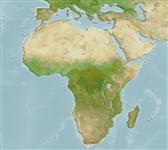Common names from other countries
Environment: milieu / climate zone / depth range / distribution range
Ecologia
; intervalo de profundidade 20 - 40 m (Ref. 122059). Subtropical; 34°S - 33°S, 18°E - 27°E (Ref. 4)
Eastern Atlantic: South Africa and UK.
Length at first maturity / Tamanho / Peso / Idade
Maturity: Lm ? range ? - ? cm Max length : 12.9 cm TL macho/indeterminado; (Ref. 122061); 9 cm TL (female); common length : 10.0 cm TL macho/indeterminado; (Ref. 4)
It has a total body length of 8 to 10 cm; and a carapace length of 4 to 5 cm (Ref. 4). Occurs at shallow coastal waters, rock pools (Ref. 4).
Life cycle and mating behavior
Maturidade | Reprodução | Desova | Ovos | Fecundidade | Larvas
Members of the order Decapoda are mostly gonochoric. Mating behavior: Precopulatory courtship ritual is common (through olfactory and tactile cues); usually indirect sperm transfer.
Holthuis, L.B. 1991. (Ref. 4)
Status na Lista Vermelha da IUCN (Ref. 130435)
Status no CITES (Ref. 108899)
Not Evaluated
Not Evaluated
Uso pelos humanos
Pescarias: sem interesse
| FishSource |
Ferramentas
Mais informação
Idade/TamanhoCrescimentoComprimento-pesoComprimento-comprimentoMorfologiaLarvasAbundância
Fontes da internet
Estimates based on models
Categoria de preço
Unknown.
